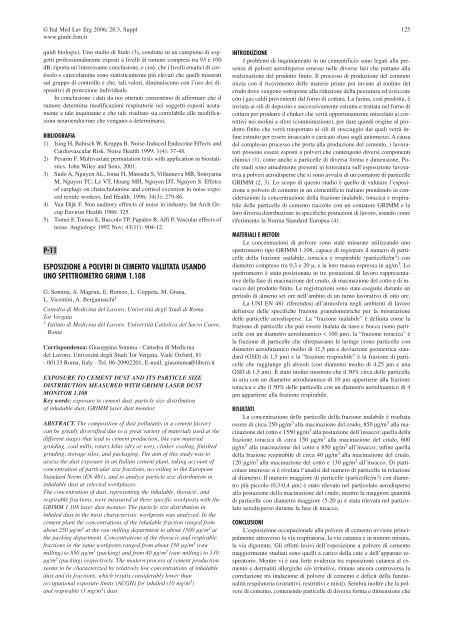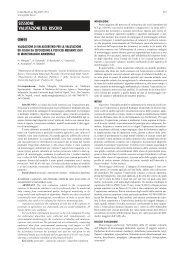Indice - Giornale Italiano di Medicina del Lavoro ed Ergonomia ...
Indice - Giornale Italiano di Medicina del Lavoro ed Ergonomia ...
Indice - Giornale Italiano di Medicina del Lavoro ed Ergonomia ...
Create successful ePaper yourself
Turn your PDF publications into a flip-book with our unique Google optimized e-Paper software.
G Ital M<strong>ed</strong> Lav Erg 2006; 28:3, Suppl 125<br />
www.gimle.fsm.it<br />
qui<strong>di</strong> biologici. Uno stu<strong>di</strong>o <strong>di</strong> Sudo (3), condotta su un campione <strong>di</strong> soggetti<br />
professionalmente esposti a livelli <strong>di</strong> rumore compresi tra 93 e 100<br />
dB, riporta un’interessante conclusione, e cioè, che i livelli ematici <strong>di</strong> cortisolo<br />
e catecolamine sono statisticamente più elevati che quelli misurati<br />
sul gruppo <strong>di</strong> controllo e che, tali valori, <strong>di</strong>minuiscono con l’uso dei <strong>di</strong>spositivi<br />
<strong>di</strong> protezione in<strong>di</strong>viduale.<br />
In conclusione i dati da noi ottenuti consentono <strong>di</strong> affermare che il<br />
rumore determina mo<strong>di</strong>ficazioni respiratorie nei soggetti esposti acutamente<br />
a tale inquinante e che tale risultato sia correlabile alle mo<strong>di</strong>ficazioni<br />
neuroendocrine che vengano a determinarsi.<br />
BIBLIOGRAFIA<br />
1) Ising H, Babisch W, Kruppa B. Noise-Induc<strong>ed</strong> Endocrine Effects and<br />
Car<strong>di</strong>ovascular Risk. Noise Health 1999; 1(4): 37-48.<br />
2) Pesarin F. Multivariate permutation tests with application in biostatistics.<br />
John Wiley and Sons, 2001.<br />
3) Sudo A, Nguyen AL, Jonai H, Matsuda S, Villanueva MB, Sotoyama<br />
M, Nguyen TC, Le VT, Hoang MH, Nguyen DT, Nguyen S. Effetcs<br />
of earplugs on chatecholamine and cortisol excretion in noise expos<strong>ed</strong><br />
textile workers. Ind Health. 1996; 34(3): 279-86.<br />
4) Van Dijk F. Non au<strong>di</strong>tory effetcts of noise in industry. Int Arch Occup<br />
Environ Health 1986; 325.<br />
5) Tomei F, Tomao E, Baccolo TP, Papaleo B, Alfi P. Vascular effects of<br />
noise. Angiology 1992 Nov; 43(11): 904-12.<br />
P-11<br />
ESPOSIZIONE A POLVERI DI CEMENTO VALUTATA USANDO<br />
UNO SPETTROMETRO GRIMM 1.108<br />
G. Somma, A. Magrini, E. Romeo, L. Coppeta, M. Grana,<br />
L. Vicentini, A. Bergamaschi1 Catt<strong>ed</strong>ra <strong>di</strong> Me<strong>di</strong>cina <strong>del</strong> <strong>Lavoro</strong>, Università degli Stu<strong>di</strong> <strong>di</strong> Roma<br />
Tor Vergata<br />
1 Istituto <strong>di</strong> Me<strong>di</strong>cina <strong>del</strong> <strong>Lavoro</strong>. Università Cattolica <strong>del</strong> Sacro Cuore,<br />
Roma<br />
Corrispondenza: Giuseppina Somma - Catt<strong>ed</strong>ra <strong>di</strong> Me<strong>di</strong>cina<br />
<strong>del</strong> <strong>Lavoro</strong>, Università degli Stu<strong>di</strong> Tor Vergata, Viale Oxford, 81<br />
- 00133 Roma, Italy - Tel. 06-20902201, E-mail: giusomma@libero.it<br />
EXPOSURE TO CEMENT DUST AND ITS PARTICLE SIZE<br />
DISTRIBUTION MEASURED WITH GRIMM LASER DUST<br />
MONITOR 1.108<br />
Key words: exposure to cement dust, particle size <strong>di</strong>stribution<br />
of inhalable dust, GRIMM laser dust monitor.<br />
ABSTRACT. The composition of dust pollutants in a cement factory<br />
can be greatly <strong>di</strong>versifi<strong>ed</strong> due to a great variety of materials us<strong>ed</strong> at the<br />
<strong>di</strong>fferent stages that lead to cement production, like raw material<br />
grin<strong>di</strong>ng, coal mills, rotary kilns (dry or wet), clinker cooling, finish<strong>ed</strong><br />
grin<strong>di</strong>ng, storage silos, and packaging. The aim of this study was to<br />
assess the dust exposure in an Italian cement plant, taking account of<br />
concentration of particular size fractions, accor<strong>di</strong>ng to the European<br />
Standard Norm (EN 481), and to analyze particle size <strong>di</strong>stribution in<br />
inhalable dust at select<strong>ed</strong> workplaces.<br />
The concentration of dust, representing the inhalable, thoracic, and<br />
respirable fractions, were measur<strong>ed</strong> at three specific workposts with the<br />
GRIMM 1.108 laser dust monitor. The particle size <strong>di</strong>stribution in<br />
inhal<strong>ed</strong> dust in the most characteristic workposts was analyz<strong>ed</strong>. In the<br />
cement plant the concentrations of the inhalable fraction rang<strong>ed</strong> from<br />
about 250 µg/m 3 at the raw milling department to about 1500 µg/m 3 at<br />
the packing department. Concentrations of the thoracic and respirable<br />
fractions in the same workposts rang<strong>ed</strong> from about 150 µg/m 3 (raw<br />
milling) to 850 µg/m 3 (packing) and from 40 µg/m 3 (raw milling) to 130<br />
µg/m 3 (packing) respectively. The modern process of cement production<br />
seems to be characteriz<strong>ed</strong> by relatively low concentrations of inhalable<br />
dust and its fractions, which results considerably lower than<br />
occupational exposure limits (ACGH) for inhal<strong>ed</strong> (10 mg/m 3 )<br />
and respirable (3 mg/m 3 ) dust.<br />
INTRODUZIONE<br />
I problemi <strong>di</strong> inquinamento in un cementificio sono legati alla presenza<br />
<strong>di</strong> polveri aero<strong>di</strong>sperse emesse nelle <strong>di</strong>verse fasi che portano alla<br />
realizzazione <strong>del</strong> prodotto finito. Il processo <strong>di</strong> produzione <strong>del</strong> cemento<br />
inizia con il ricevimento <strong>del</strong>le materie prime poi inviate al molino <strong>del</strong><br />
crudo dove vengono sottoposte alla riduzione <strong>del</strong>la pezzatura <strong>ed</strong> essiccate<br />
con i gas cal<strong>di</strong> provenienti dal forno <strong>di</strong> cottura. La farina, così prodotta, è<br />
inviata ai sili <strong>di</strong> deposito e successivamente estratta e trattata nel forno <strong>di</strong><br />
cottura per produrre il clinker che verrà opportunamente miscelato ai correttivi<br />
nei molini a sfere (comminuzione), per dare quin<strong>di</strong> origine al prodotto<br />
finito che verrà trasportato ai sili <strong>di</strong> stoccaggio dai quali verrà infine<br />
estratto per essere insaccato o caricato sfuso sugli automezzi. A causa<br />
<strong>del</strong> complesso processo che porta alla produzione <strong>del</strong> cemento, i lavoratori<br />
possono essere esposti a polveri che contengono <strong>di</strong>versi componenti<br />
chimici (1), come anche a particelle <strong>di</strong> <strong>di</strong>versa forma e <strong>di</strong>mensione. Pochi<br />
stu<strong>di</strong> sono attualmente presenti in letteratura sull’esposizione lavorativa<br />
a polveri aero<strong>di</strong>sperse che si sono avvalsi <strong>di</strong> un contatore <strong>di</strong> particelle<br />
GRIMM (2, 3). Lo scopo <strong>di</strong> questo stu<strong>di</strong>o è quello <strong>di</strong> valutare l’esposizione<br />
a polvere <strong>di</strong> cemento in un cementificio italiano prendendo in considerazione<br />
la concentrazione <strong>del</strong>la frazione inalabile, toracica e respirabile<br />
<strong>del</strong>le particelle <strong>di</strong> cemento raccolte con un contatore GRIMM e la<br />
loro <strong>di</strong>versa <strong>di</strong>stribuzione in specifiche postazioni <strong>di</strong> lavoro, usando come<br />
riferimento la Norma Standard Europea (4).<br />
MATERIALI E METODI<br />
Le concentrazioni <strong>di</strong> polvere sono state misurate utilizzando uno<br />
spettrometro tipo GRIMM 1.108, capace <strong>di</strong> registrare il numero <strong>di</strong> particelle<br />
<strong>del</strong>la frazione inalabile, toracica e respirabile (particelle/m 3 ) con<br />
<strong>di</strong>ametro compreso tra 0,3 e 20 µ, e la loro massa espressa in µg/m 3 . Lo<br />
spettrometro è stato posizionato in tre postazioni <strong>di</strong> lavoro rappresentative<br />
<strong>del</strong>la fase <strong>di</strong> macinazione <strong>del</strong> crudo, <strong>di</strong> macinazione <strong>del</strong> cotto e <strong>di</strong> insacco<br />
<strong>del</strong> prodotto finito. Le registrazioni sono state eseguite durante un<br />
periodo <strong>di</strong> almeno sei ore nell’ambito <strong>di</strong> un turno lavorativo <strong>di</strong> otto ore.<br />
La UNI EN 481 riferendosi all’atmosfera negli ambienti <strong>di</strong> lavoro<br />
definisce <strong>del</strong>le specifiche frazioni granulometriche per la misurazione<br />
<strong>del</strong>le particelle aero<strong>di</strong>sperse. La “frazione inalabile” è definita come la<br />
frazione <strong>di</strong> particelle che può essere inalata da naso e bocca (sono particelle<br />
con un <strong>di</strong>ametro aero<strong>di</strong>namico < 100 µm), la “frazione toracica” è<br />
la frazione <strong>di</strong> particelle che oltrepassano la laringe (sono particelle con<br />
<strong>di</strong>ametro aero<strong>di</strong>namico me<strong>di</strong>o <strong>di</strong> 11,5 µm e deviazione geometrica standard<br />
(GSD) <strong>di</strong> 1,5 µm) e la “frazione respirabile” è la frazione <strong>di</strong> particelle<br />
che raggiunge gli alveoli (con <strong>di</strong>ametro me<strong>di</strong>o <strong>di</strong> 4,25 µm e una<br />
GSD <strong>di</strong> 1,5 µm). È stato inoltre mostrato che il 50% circa <strong>del</strong>le particelle<br />
in aria con un <strong>di</strong>ametro aero<strong>di</strong>namico <strong>di</strong> 10 µm appartiene alla frazione<br />
toracica e che il 50% <strong>del</strong>le particelle con un <strong>di</strong>ametro aero<strong>di</strong>namico <strong>di</strong> 4<br />
µm appartiene alla frazione respirabile.<br />
RISULTATI<br />
La concentrazione <strong>del</strong>le particelle <strong>del</strong>la frazione inalabile è risultata<br />
essere <strong>di</strong> circa 250 µg/m 3 alla macinazione <strong>del</strong> crudo, 850 µg/m 3 alla macinazione<br />
<strong>del</strong> cotto e 1550 µg/m 3 alla postazione <strong>del</strong>l’insacco; quella <strong>del</strong>la<br />
frazione toracica <strong>di</strong> circa 150 µg/m 3 alla macinazione <strong>del</strong> crudo, 600<br />
µg/m 3 alla macinazione <strong>del</strong> cotto e 850 µg/m 3 all’insacco; infine quella<br />
<strong>del</strong>la frazione respirabile <strong>di</strong> circa 40 µg/m 3 alla macinazione <strong>del</strong> crudo,<br />
120 µg/m 3 alla macinazione <strong>del</strong> cotto e 130 µg/m 3 all’insacco. Di particolare<br />
interesse si è rivelata l’analisi <strong>del</strong> numero <strong>di</strong> particelle in relazione<br />
al <strong>di</strong>ametro. Il numero maggiore <strong>di</strong> particelle (particelle/m 3 ) con <strong>di</strong>ametro<br />
più piccolo (0,3-0,4 µm) è stato rilevato nel particolato aero<strong>di</strong>sperso<br />
alla postazione <strong>del</strong>la macinazione <strong>del</strong> crudo, mentre la maggiore quantità<br />
<strong>di</strong> particelle con <strong>di</strong>ametro maggiore (5-20 µ) è stata rilevata nel particolato<br />
aero<strong>di</strong>sperso durante la fase <strong>di</strong> insacco.<br />
CONCLUSIONI<br />
L’esposizione occupazionale alla polvere <strong>di</strong> cemento avviene principalmente<br />
attraverso la via respiratoria, la via cutanea e in minore misura,<br />
la via <strong>di</strong>gerente. Gli effetti lesivi <strong>del</strong>l’esposizione a polvere <strong>di</strong> cemento<br />
maggiormente stu<strong>di</strong>ati sono quelli a carico <strong>del</strong>la cute e <strong>del</strong>l’apparato respiratorio.<br />
Mentre vi è una forte evidenza tra esposizione cutanea al cemento<br />
e dermatiti allergiche e/o irritative, rimane ancora controversa la<br />
correlazione tra inalazione <strong>di</strong> polvere <strong>di</strong> cemento e deficit <strong>del</strong>la funzionalità<br />
respiratoria (ostruttivi, restrittivi e misti). Sembra inoltre che la polvere<br />
<strong>di</strong> cemento, contenendo particelle <strong>di</strong> <strong>di</strong>versa forma e <strong>di</strong>mensione che
















